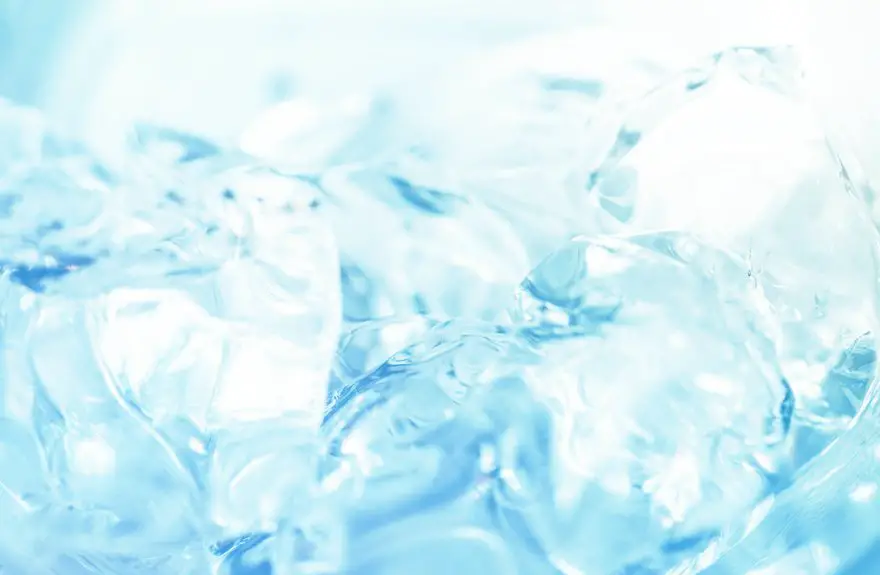Putting ice cubes in the dryer can indeed help remove wrinkles. As the ice melts, it creates steam that relaxes fabric fibers, working best on synthetic and wrinkle-prone materials. This method is a quick, convenient alternative to traditional ironing, though it might not be effective on all fabrics, especially delicate ones. Plus, overloading the dryer can reduce its effectiveness. If you’re curious about tips for ideal results and more details, you’ll want to keep exploring this method.
Table of Contents
Key Takeaways
- Tossing ice cubes in the dryer generates steam, which helps relax fabric fibers and reduce wrinkles.
- This method is effective for synthetic and wrinkle-prone fabrics but less so for delicate materials like silk.
- Ice cubes provide a quick alternative to traditional ironing without needing an ironing board or waiting for an iron to heat up.
- Overloading the dryer can diminish effectiveness, so it’s best to dry smaller loads for optimal results.
- Always test on a small fabric area first to ensure compatibility and avoid damage from moisture or heat.
Basic Concept of the Method
When you toss a few ice cubes into your dryer, you’re not just trying to cool things down; you’re tapping into a clever trick to eliminate wrinkles from your clothes.
The basic concept behind this method is simple: as the ice cubes melt, they create steam. This steam helps relax the fibers in your fabrics, making it easier for creases to fall out.
You’ll want to run the dryer on a medium heat setting for about 15-20 minutes. This short burst of steam is often enough to refresh your garments without the need for ironing.
Plus, it’s a quick and easy solution for busy days when you need your clothes looking sharp without the hassle.
How Steam Is Generated
When you toss ice cubes into the dryer, they start melting due to the heat inside.
As the ice turns into water, the heat interacts with it, generating steam. This steam is what helps to smooth out wrinkles in your clothes.
Ice Melting Process
As ice cubes melt in the dryer, they undergo a fascinating transformation that generates steam.
When you toss ice cubes into a warm dryer, the heat from the drum starts to raise the temperature of the ice. This causes the solid ice to absorb energy, breaking the bonds between its molecules. You’ll notice the ice slowly turning into water as it reaches its melting point.
As the process continues, the water begins to evaporate, creating steam. This steam fills the dryer, surrounding your clothes and helping to relax the fibers.
You’re fundamentally using the melting ice to introduce moisture into your laundry cycle, which can effectively aid in wrinkle reduction. It’s a simple yet clever method to refresh your garments!
Heat and Steam Interaction
The process of melting ice in the dryer not only introduces moisture but also plays a key role in generating steam. As the dryer heats up, the ice cubes begin to melt, releasing water into the drum.
This water quickly turns into steam due to the dryer’s high temperature. The steam then circulates around your clothes, helping to relax the fibers and remove wrinkles.
You’ll notice that as the steam penetrates the fabric, it softens the material, making it easier to eliminate stubborn creases. This interaction between heat and steam is essential for effective wrinkle removal.
Effectiveness Across Different Fabrics
While you might expect ice cubes to work wonders on all fabrics, their effectiveness can vary greatly. For natural fibers like cotton and linen, the combination of heat and steam generated from melting ice can help release stubborn wrinkles.
However, synthetic fabrics like polyester and nylon mightn’t respond as well, since they often require different care. You might find that while some wrinkles vanish, others persist.
Additionally, delicate fabrics like silk may not benefit at all from this method, as the added moisture could cause damage. It’s essential to evaluate the fabric type before relying on ice cubes, as the outcome can differ markedly based on what you’re trying to de-wrinkle.
Required Materials for the Hack
To successfully use ice cubes in your dryer for wrinkle removal, you’ll need just a few simple materials. This hack is easy and doesn’t require much prep.
Here’s what you’ll need:
- Ice cubes: Use a handful of ice cubes, ideally about three or four, to create steam while the dryer runs.
- Wrinkle-prone clothes: Select clothes that are prone to wrinkling, like cotton or linen, to maximize the effectiveness of the method.
- Dryer: Make sure you have a working dryer, as this method relies on heat and moisture to relax the fabric fibers.
With these materials on hand, you’re ready to tackle those pesky wrinkles without reaching for an iron!
Comparison With Traditional Ironing Methods
When you compare using ice cubes in the dryer to traditional ironing methods, you’ll find that the former offers a quicker and more convenient solution.
Instead of setting up an ironing board and waiting for your iron to heat up, you can toss a few ice cubes in with your wrinkled clothes and let the dryer do the work. This method requires far less time and energy, especially for busy individuals.
Plus, there’s no risk of burning your fabric or spending time perfecting those hard-to-reach areas. The ice cube method also minimizes the need for additional products like starch or sprays, making it a simpler and more efficient alternative.
Ultimately, it’s an easy fix for maintaining wrinkle-free clothing without the hassle of traditional ironing.
Limitations of the Ice Cube Method
Although the ice cube method is a convenient alternative to traditional ironing, it does have its limitations.
First, it mightn’t be effective on all fabrics. Delicate materials like silk or lace can be damaged by the moisture or heat.
Second, the method may require multiple cycles to achieve desired results, which can be time-consuming.
Finally, stubborn wrinkles, particularly in thicker fabrics, often resist this technique, leaving you with less than satisfactory outcomes.
- It’s less effective on heavy or structured garments.
- The method doesn’t provide crisp edges like an iron does.
- It relies on the dryer’s efficiency and may not work well with overloaded machines.
Practical Applications in Everyday Life
While you mightn’t reach for an iron every day, the ice cube method can be a game-changer in your regular laundry routine. Instead of spending time steaming or ironing your clothes, toss a few ice cubes in the dryer with your wrinkled garments.
The moisture from the melting ice creates steam, helping to relax the fabric and smooth out wrinkles. This trick is perfect for busy mornings when you need to look sharp but don’t have the time for traditional methods.
It works well on various fabrics, from cotton to synthetic blends, making it versatile for your wardrobe. Plus, it’s an eco-friendly option that saves energy, giving you one less reason to dread laundry day.
Tips for Optimal Results
To get the best results with ice cubes in the dryer, choose the right fabrics and adjust your dryer settings accordingly.
Certain materials respond better to steam, so it’s smart to know what you’re working with.
Also, using the right heat and time settings can make all the difference in achieving wrinkle-free clothes.
Fabric Selection Tips
When choosing fabrics for your laundry, you’ll want to contemplate how well they respond to the ice cube method for reducing wrinkles. Certain materials handle this technique better than others, so consider the following tips for best results:
- Cotton: This natural fiber tends to hold wrinkles, but it can benefit from the steam created by melting ice cubes.
- Polyester: Often wrinkle-resistant, polyester can still gain extra softness and reduced creasing with this method.
- Linen: While linen wrinkles easily, using ice cubes can help relax the fibers for a smoother finish.
Dryer Settings Adjustment
Selecting the right fabrics is just the beginning; adjusting your dryer settings plays a significant role in achieving wrinkle-free results. Here are some tips for ideal settings:
| Setting | Recommendation |
|---|---|
| Drying Cycle | Use a “Permanent Press” cycle to reduce heat and prevent wrinkles. |
| Temperature | Choose medium heat for synthetic fabrics and low heat for delicates. |
| Load Size | Dry smaller loads for even heat distribution and better results. |
| Time | Set shorter drying times, checking frequently to avoid over-drying. |
| Dampness Level | Keep clothes slightly damp for easier wrinkle removal with ice cubes. |
Frequently Asked Questions
Can I Use Crushed Ice Instead of Ice Cubes?
You can definitely use crushed ice instead of ice cubes. In fact, studies show that using ice in dryers can reduce wrinkles by up to 25%. So, go ahead and experiment with crushed ice!
How Many Ice Cubes Should I Use for Best Results?
For best results, you should use about three to five ice cubes in the dryer. This quantity balances moisture release without overloading, ensuring your clothes come out smoother and fresher without excessive dampness.
Is This Method Safe for All Dryer Types?
Not every dryer’s built the same, so you should check your manual first. Most modern dryers can handle ice cubes, but older models might not. You don’t want to risk damaging your appliance!
Will This Method Work on Dry-Clean-Only Fabrics?
You shouldn’t use this method on dry-clean-only fabrics. The heat and moisture from ice cubes can damage delicate materials, leading to shrinkage or distortion. Stick to professional cleaning for those items to guarantee their longevity.
Can I Leave Clothes in the Dryer After the Cycle Ends?
You can leave clothes in the dryer briefly after the cycle ends, but it’s best to remove them soon. Leaving them too long might cause wrinkles or a musty smell from trapped moisture.
- Does Chiffon Fabric Stink - July 15, 2025
- Does Chiffon Fabric Affect the Economy - July 15, 2025
- Does Cotton Fabric Have a Nap - July 15, 2025







